Traditional snowshoes have been around for thousands of years. First, they were first developed as a transportation method from place to place. Then, like modern snowshoes, they evolved over time. As a result, traditional wooden snowshoes have various design traits and styles to be aware of, each serving a unique purpose.
Also, though wooden snowshoes are aesthetically pleasing, they are not just for aesthetic purposes. As Jim Baker, owner of Iverson Snowshoes, notes, “While modern snowshoes have their place and offer advantages in some applications, wooden snowshoes also have performance advantages in certain applications. In particular, wooden snowshoes offer excellent floatation in off-trail or backcountry settings and are silent when in use”.
In this article, we’ll review the central design features of traditional snowshoes and the characteristics of each style, including the manufacturers who offer that style today.
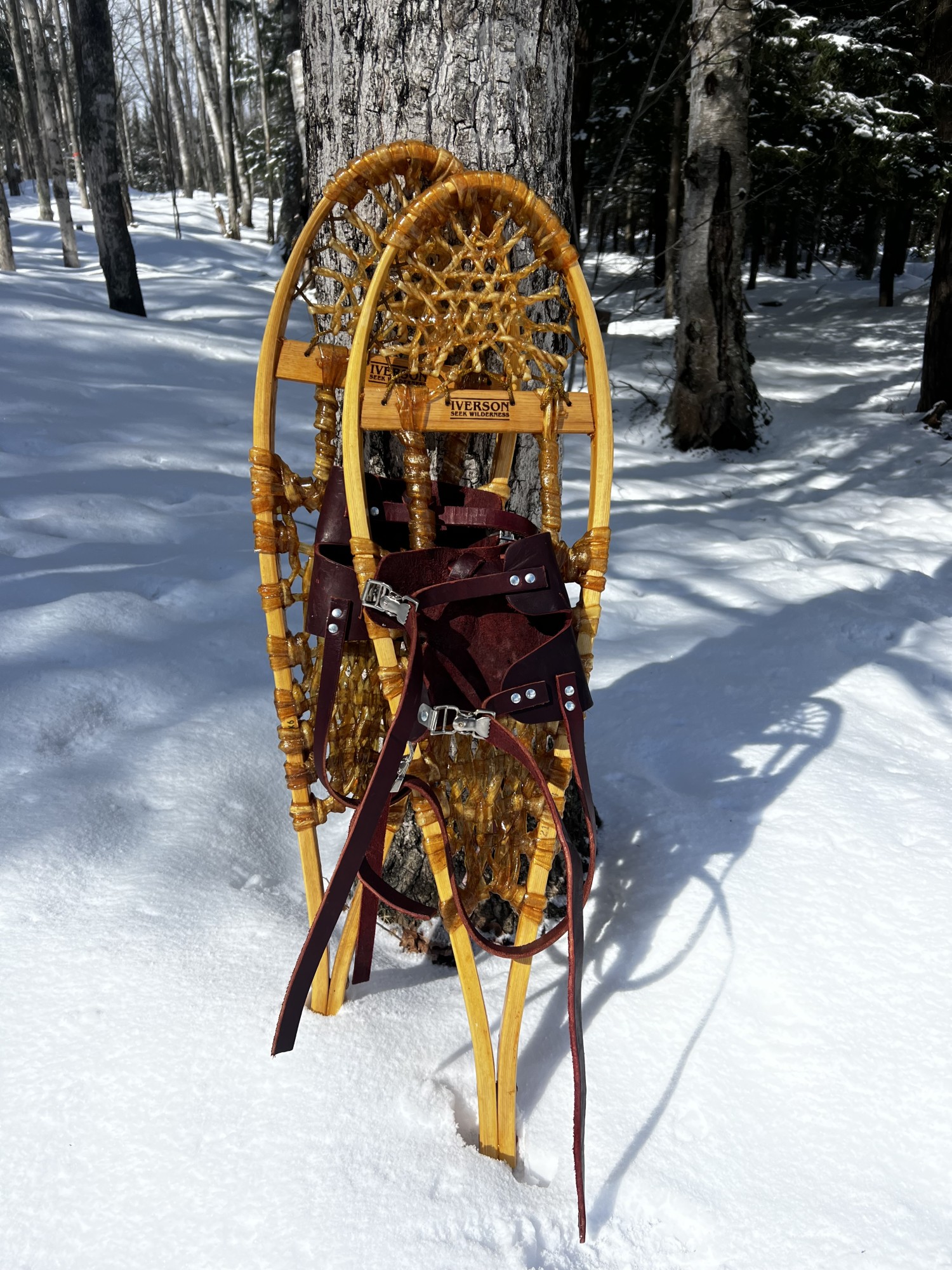
Wooden snowshoes can offer more than an aesthetic presence and come in a variety of styles (like the Huron/Michigan snowshoes pictured here). Each style also serves its own unique purpose. Photo: Victoria Baker, Iverson Outdoors Inc.
Some of the links in this article may contain affiliate links. When you purchase using these links, part of the proceeds go to Snowshoe Mag. These proceeds may help us pay for site maintenance and article contributions. Additionally, as an Amazon Associate, I earn from qualifying purchases. Please see our disclosure for more details.
Traditional Wooden Snowshoe Design Features and Morphology
The distinctive design features of traditional snowshoes or raquettes are the frame shape, frame points, and crossbar. When we refer to the morphology of the snowshoe, we are referring to the “shape, form, external structure or arrangement [of the snowshoe], esp. as an object of study or classification” 1
These features are similar to those you would find in a modern snowshoe. In fact, “For on-trail recreational applications, the Green Mountain model has a similar profile to modern snowshoes made in traditional style,” mentions Baker. Thus, he recommends the Green Mountain snowshoe (overviewed below) has good mobility and is easy to transport, so it makes for a smooth transition from modern to traditional snowshoes.
Let’s take a look at each aspect of the morphology in depth.
Frame Shape
Most traditional snowshoes include a one or two-piece frame. Then, additional components are attached within and upon the frame.
There are only a few exceptions to this design. The first is solid-bodied snowshoes made from a single plank of wood or injection-molded plastic. The second is those used as emergency devices made from bundled boughs.
The frame shape of traditional snowshoes tends to be the most distinctive identifying feature. Thus, common shapes include:
- ovular – egg-shaped or shaped like an oval
- lenticular – lens-shaped
- teardrop – rounded on the front end, a distinct point on the back end, similar to a tear
- rectangular
- round shape
- footed – one of the two snowshoes is designed to be worn on the left foot and the other to be worn on the right
If viewed from the side, the frame may be flat or upturned at one or more points, leading us to our next design feature.
Read More: A Few U.S Artisans Keep Traditional Snowshoes a Tradition
Frame Points
Another unique feature of wooden snowshoes is the shape at their ends (or lack of ends in the case of round snowshoes).
The front end/nose is where an upturn is most likely seen. Furthermore, the front end/nose shape can be a straight edge to a point, a cusp, or somewhere in between. A straight-edge nose is part of the rectangular design, and a cusp is a pointed end where two curves meet.
As with the front end, the back end of a snowshoe may be rectangular, rounded, or come to a point.
Also, a tail may or may not be present at the very back end of the snowshoe. If the tail is relatively small compared to the whole snowshoe, it is either a swallowtail (pointed) or a beavertail (rounded). Alternatively, it is a trailer if the tail is relatively long compared to the entire snowshoe. A trailer must also come to a point, and most of the tail length must contain no webbing.
Read More: Making Your Snowshoes From Scratch
Crossbar(s)
The frame of most snowshoes includes at least one slat running side-to-side between the frame’s inner edges, known as a crossbar.
A typical design consists of two crossbars. Usually, one crossbar is placed near the front end (toe bar), and the other is near the back end (heel bar).
Configurations including more than two crossbars typically include a toe bar and a heel bar, with the remaining crossbars utilized as spacers. Snowshoes with a single crossbar may see it placed 1) as a toe bar or 2) roughly along the shortest area horizontally across the snowshoe.
Read More: How To Repair Traditional Wooden Snowshoes
Lacing
In addition to the structure, you will most likely see traditional wooden snowshoes that include either neoprene or rawhide lacing as decking on the snowshoe. These lacings have a few distinct differences, and Baker from Iverson Snowshoes mentions a few benefits and considerations of each option.
Specifically, “Rawhide is genuinely traditional and considered by many to be more aesthetically pleasing than neoprene. [However, rawhide] is a little heavier than neoprene and requires periodic maintenance with a coat of spar varnish.” Alternatively, “Neoprene is maintenance free with a lighter weight and more modern look.”
“Both materials will offer hundreds of miles of service on the trail, but a properly maintained rawhide snowshoe will generally outlast a pair of neoprene-laced snowshoes, ” he continues.
Read More: How To Maintain Your Snowshoes
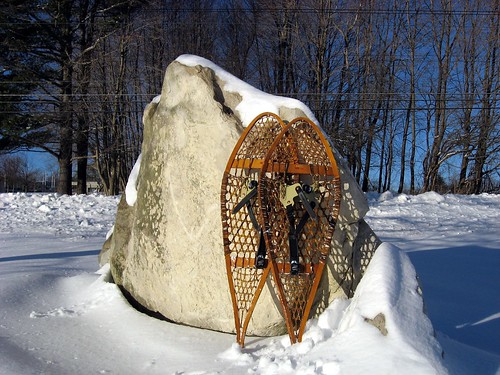
Traditional snowshoe with a teardrop frame shape. Many snowshoes have an option for rawhide or neoprene lacing, which each offers its own benefits. Photo: Matthew Timothy Bradley
Traditional Snowshoe Types and Styles
Snowshoes come in various formally named types and styles, each with different design features discussed above. 2 In addition to the most common styles described below, you can also find traditional wooden snowshoes for racing and youth.
As a note, wooden snowshoes are typically sold with a weight rating primarily based on floatation in moderately settled snow conditions. Baker mentions,” There is a bit of room around the floatation ratings depending on the conditions they will be used in…The frames can handle weight over the rating as long as they are not bridged by having the toe or heel elevated, such as on a rock or log. [Also], the frames are designed to hold the weight of the snowshoer distributed across the lacing rather than fully bearing on the wood.”
An example Baker mentions regarding flexibility in the ratings is that “Excellent floatation is not needed on a trail that has been broken by even a single snowshoer on in snow that has had time to settle between heavy snowfall events.”
Read More: Tips for Learning When You Need Snowshoes
Elbow
An elbow snowshoe, using the strictest sense of the term,3
- has an ovular frame,
- lacks a tail/trailer,
- has a slightly upturned or flat nose, and
- incorporates both a toe bar and a heel bar.
Elbow snowshoes are excellent for those who spend time in dense brush. Tailed snowshoes may snag on the deadfall or underbrush. However, since the elbow snowshoe does not have a tail, it has a definite advantage.
Read More: Snowshoe Makers and Manufacturers That Were
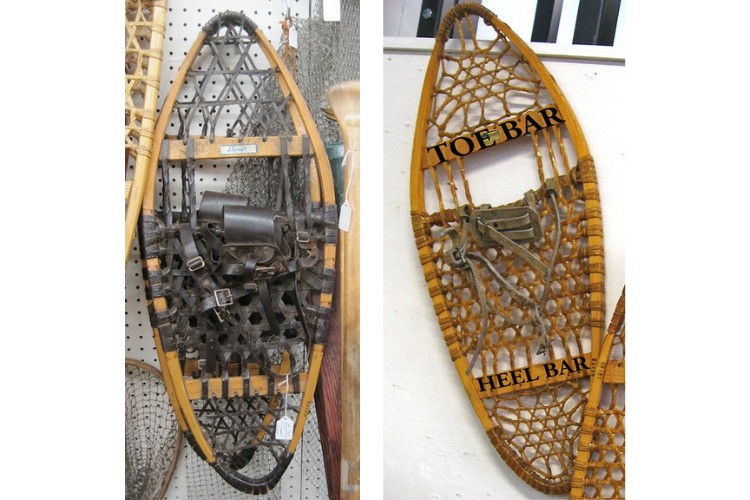
These Elbow snowshoes have an ovular frame with a toe and heel bar. They also lack a tail. Photos: Matthew Timothy Bradley
Bearpaw
A Bearpaw snowshoe, using the strictest sense of the term:
- has an ovular frame,
- lacks a tail/trailer,
- incorporates a toe bar
- does not have a heel bar.
At some point in the past, the scope of the term Bearpaw expanded, and it has now come to include all tailless wood frame snowshoes. Previously, most snowshoes currently marketed as Bearpaws would have been Elbows.
Bearpaw snowshoe manufacturers include:
GV Snowshoes
12 x 30, 14 x 32, and 16 x32 (available in rawhide and synthetic laces)
Modified Bearpaw
The term ‘modified Bearpaw’ may refer to one of two types of snowshoes.
The first is of the form innovated by Floyd Westover, an ovular snowshoe with both toe and heel bars and with a swallowtail. Not surprisingly, this type of snowshoe is known as a Westover-style snowshoe.4 The second type of modified Bearpaw is a Green Mountain-style snowshoe, described below.
The Modified Bearpaw snowshoe manufacturers include:
Iverson
12 x 35 and 13 x 35 (available in rawhide and neoprene laces)
GV Snowshoes
10 x 30, 10 x 36, and 11 x 40 (available in rawhide and synthetic laces)
Maine Guide Snowshoes
13 x 36 and 14 x 36
Read More: Traditional Maine Guide Snowshoes: The Real Deal
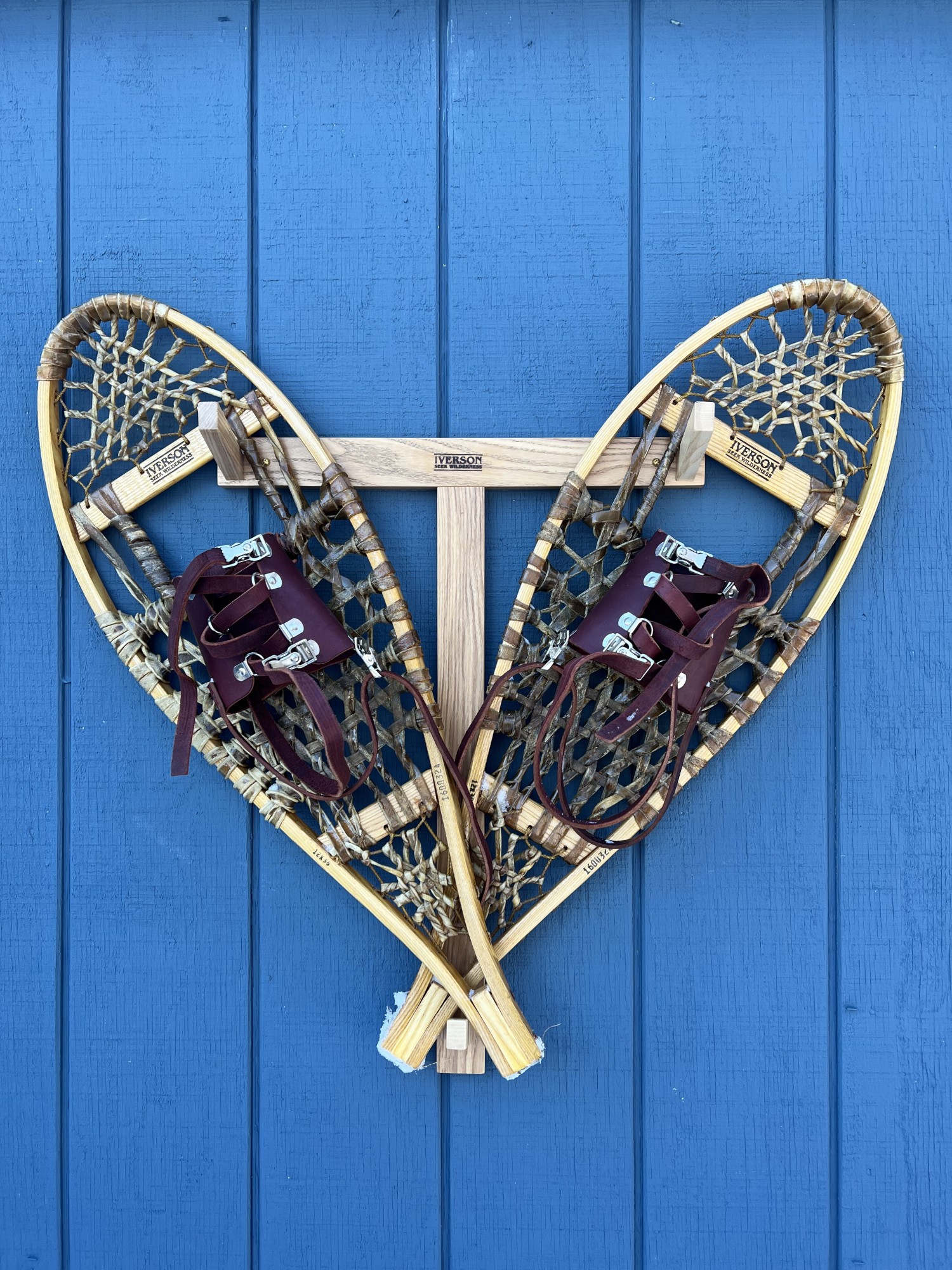
These Modified Bearpaw snowshoes include a toe and heel bar and a swallowtail. Photo: Victoria Baker, Iverson Outdoors Inc.
Green Mountain
A Green Mountain snowshoe is:
- lenticular
- tailless
- incorporates both a toe and a heel bar, and
- has a moderate upturn at the nose
The Green Mountain is the traditional form used most by modern snowshoe models. Thus, as noted above by Baker from Iverson Snowshoes, the Green Mountain snowshoe could offer a smooth transition from modern to traditional snowshoes.
The narrow width of the Green Mountain decreases flotation, and you may sink more in deep snow. However, the design helps you go along narrow upland paths, and these ‘shoes stow conveniently on your backpack.
Green Mountain snowshoe manufacturers include:
Iverson
9 x 30, 10 x 36, 12 x 44 (available in rawhide and neoprene laces)
Country Ways
10 x 36
Read More: How To Attach Snowshoes to a Pack (3 Methods)
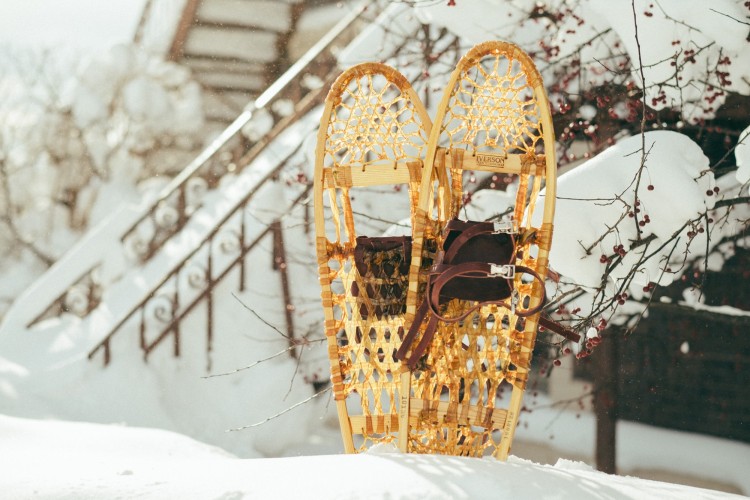
The Green Mountain snowshoe can offer a smooth transition from modern to traditional snowshoes. The design allows for travel along narrow paths, and the snowshoes can be stored easily on your backpack. Photo: Adam Johnson, Brockit Inc.
Huron
A Huron snowshoe is
- teardrop-shaped
- has a moderately upturned nose
- has a distinctly long trailer compared to its overall length
- has both a toe and a heel bar
The Huron snowshoe is also sometimes known as the Michigan-style and excels on flat and rolling terrain covered by deep snowpack. Baker of Iverson Snowshoes notes that “for those looking to transition to wooden snowshoes to take advantage of the increased flotation in off-trail and backcountry applications, this style is a great all-around utility shape that works in a wide variety of conditions and applications.”
For example, the upturned noses help avoid digging into snowbanks and nasty face plants. Also, the long tails help the snowshoes track straight through rolling terrain and drifts.
Huron snowshoe manufacturers include:
Iverson
12 x 46 and 13 x 46 (Michigan)
Country Ways
12 x 42
GV Snowshoes
9 x 29 Rawhide Laces
10 x 33, 11 x 36, 12 x 42 , 14 x 48
Read More: Ask Us Your Traditional Snowshoe Questions
Ojibwe
An Ojibwe, also called Ojibwa snowshoe, includes:
- a cusped and prominently upturned nose
- long overall length, which may reach five feet
- has a trailer
- often make use of three or more crossbars
Because of their length, Ojibwe snowshoes are not recommended when climbing is required. However, they are excellent for use on flat ground. Also, the Ojibwe have a large surface area and, therefore, are recommended for large wearers or when bearing heavy loads.
Obijwe(a) snowshoe manufacturers include:
Iverson Snowshoes
11 x 56 and 12 x 60
GV Snowshoes
10 x 48 and 11 x 54
Country Ways
9 x 36; 10 x 48; 11 x 54; 12 x 60
Read More: Connecting to Lineage: Crossing Paths On My Ojibwa Snowshoes
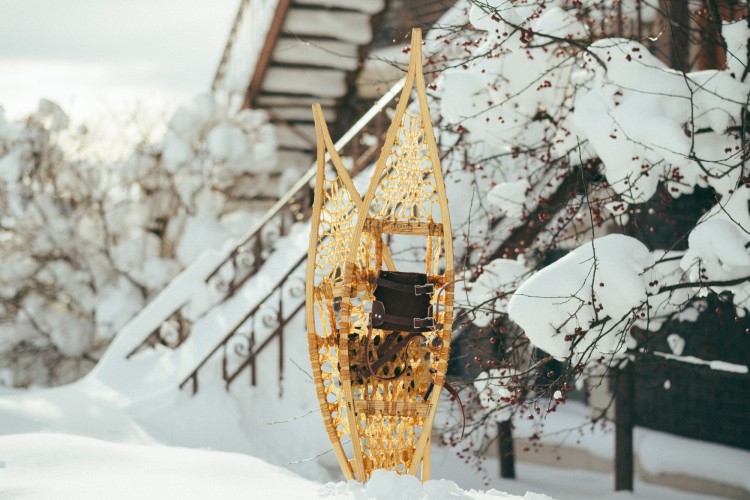
Ojibwe snowshoes are excellent for flat landscapes and have great floatation in the snow when carrying heavy loads. Photo: Adam Johnson, Brockit Inc.
Alaskan
An Alaskan snowshoe is similar to the Ojibwe style. Thus, the key traits of the Alaskan snowshoe are:
- long overall length, which may reach five feet
- has a trailer
- often makes use of three or more crossbars
- a rounded nose (as opposed to the cusp nose of the Ojibwe)
Also, the Alaskan is best when traveling flat ground and carrying heavy loads.
Alaskan snowshoe manufacturers include:
Iverson Snowshoes
10 x 56 and 12 x 60
GV Snowshoes
10 x 46, Rawhide or Synthetic Laces
10 x 56, Rawhide Laces
Maine Guide Snowshoes
12 x 60
Country Ways
10 x 56; 12 x 60
Read More: Traditional Snowshoe Care and Maintenance
Montagnais
Finally, a Montagnais snowshoe has the following traits:
- noticeably round with little or no upturn at the nose,
- has a swallow or beavertail.
The width of this type makes for a less-than-natural stride. Additionally, this type evolved in Subarctic areas for large amounts of snow. Thus, this snowshoe’s large surface area provides excellent flotation (less sinking) in deep powder and drifts.
This article was originally published on November 25, 2012. The most recent update to this article, including quotations from a traditional snowshoe manufacturer, was added on October 29, 2023.
Read Next: A Historical Perspective of Snowshoes
Notes and Bibliography
1. OED.↩
2. Prater, chart I, and Heilman are good rundowns of named snowshoe styles.↩
3. “Mushu Innu Bearpaw Snowshoes,” Hudson Museum.↩
4. See Heilman as well as Norton.↩
5. Pospisil.↩
- Burgesse, j.a. “Snowshoes,” The Beaver 271: 24–28. Mar 1941.
- Davidson, Daniel Sutherland. Snowshoes. Vol. 6 in Memoirs of the American Philosophical Society. Philadelphia, 1937. OCLC = 3394641.
- Drummond, Thomas. “The Canadian snowshoe,” Transactions of the Royal Society of Canada, section 2. Series 3, vol. 10: 305–20 + pl. 1–6. Dec. 1916.
- Heilman, Carl, ii. “If you can walk… you can snowshoe.” http://www.carlheilman.com/snowshoes-walk.html. 2008.
- Hudson Museum, The University of Maine. Snowshoes: a gift from Gluskabe. [Online exhibition.] http://umaine.edu/hudsonmuseum/exhibits/online/snowshoes/. 2009.
- Mason, Otis Tuft. “Travel and transportation,” pp. 237–593 + pl. 1–25 in Report of the U.S. National Museum for 1894. Washington, 1896. (see pp. 381–410 for information on snowshoes)
- Norton, Mortimer. “Outdoors,” Schenectady Gazette, February 2, 1963, 17. Available online via Google News at http://tinyurl.com/a3znd73.
- Oxford English Dictionary Online. “morphology, n.” September 2012. Oxford University Press. http://www.oed.com/view/Entry/122369?redirectedFrom=morphology& (accessed November 15, 2012).
- Osborne, Carolyn M.; Appleby, Kristyn; Kershner, Pat. “A technical analysis of three forms of Sub-Arctic snowshoes,” Arctic Anthropology 14(2): 41–78. 1977.
- Pospisil, Allan. “At Vermont Tubbs, they still make snowshoes the way they used to,” Sports Illustrated 51(21): 6. November 19, 1979. Available online at http://sportsillustrated.cnn.com/vault/article/magazine/MAG1126307/index.htm.
- Prater, Gene. Snowshoeing: from novice to master. 5th ed., Dave Felkley, ed. Seattle: Mountaineers Books. 2002. OCLC = 427437682.
- Speck, Frank G. “Notes on the material culture of the Huron,” American Anthropologist, n.s., 13(2): 208–28 + pl. Viii–XI Apr.–Jun. 1911. DOI: 10.1525/aa.1911.13.2.02a00020.
- Wintertrekking.com. Traditional snowshoe designs. http://wintertrekking.com/snowshoeing/traditional-snowshoe-designs/. 2012.


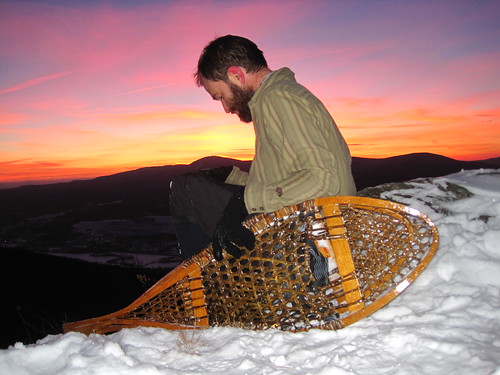

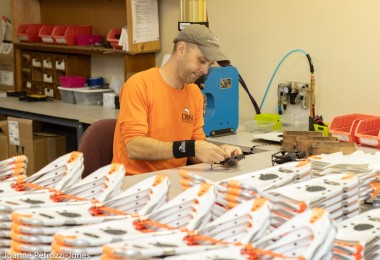
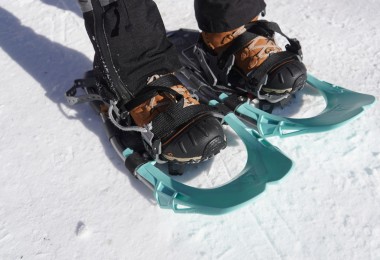
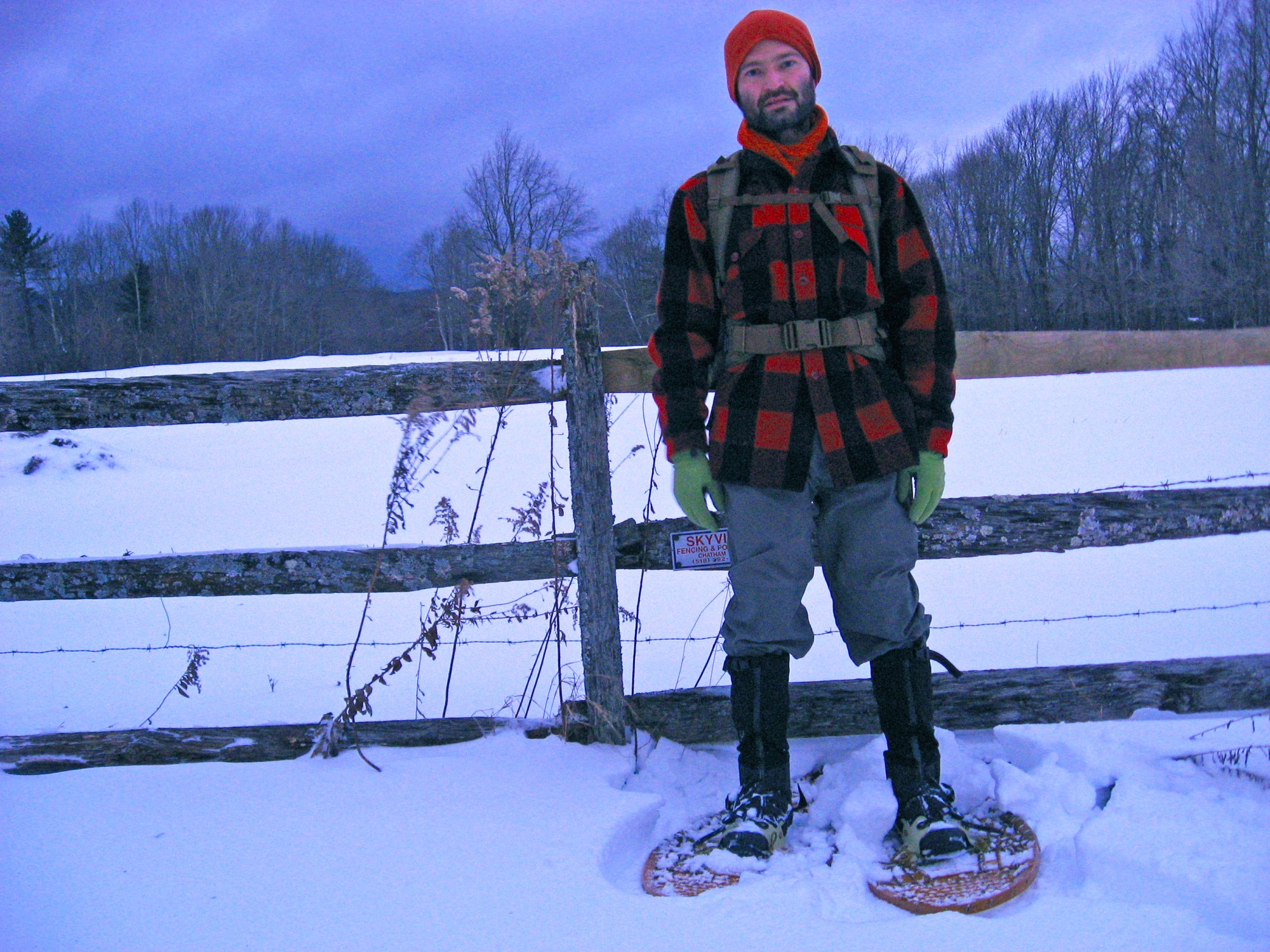
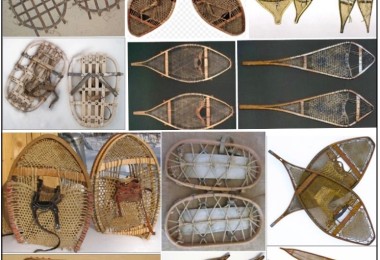

Nicely done and extremely complete. I enjoy reading your articles.